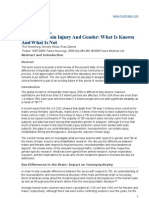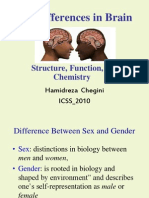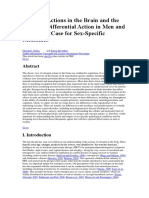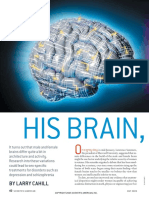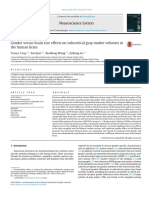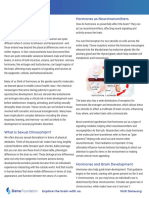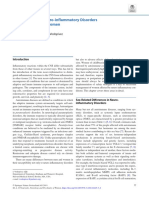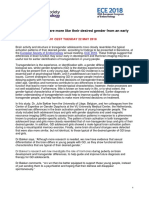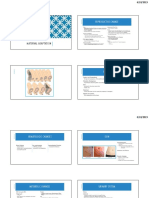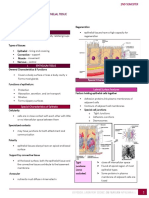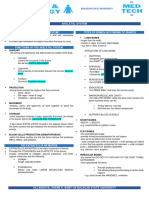Characterization of Microglial Activation in Hypothalamic
Nuclei of Male and Female Mice
Introduction:
Inflammation occurs in the body in response to infection or injury and plays a role in the
pathophysiology of many diseases such as Alzheimer’s disease, diabetes, and some cancers.
(Kirkpatrick & Miller, 2013) Innate inflammation has been linked to both psychiatric disorders
and the glutamatergic and monaminergic abnormalities associated with them (Najjar et al.
2013). Recent data reveals “reliable associations of inflammatory markers with psychiatric
disorders, the induction of psychiatric symptoms following administration of inflammatory
stimuli, the association of inflammation-related genes with psychiatric disease, and the
elucidation of neurobiological and immunological mechanisms by which inflammation targets
neurotransmitters and neuro-circuits to change behavior” (Miller & Raison, 2015). With the
large role that inflammation plays in an assortment of diseases, it is important to look at the
varying ways that inflammation is induced in males and females and the physiological
consequences it has.
Microglia cells are the resident macrophages of the central nervous system, comprising
approximately 12% of the brain (Lull & Block, 2010). In a normal, healthy brain, microglia are
referred to as ‘resting’, and they are distinguished by their morphology (Well, lots of other
things too, but morphology is a big one. Cite this.) In this state, they have the ability scan the
environment by extending and retracting their processes in order to survey the environment
and identify signals that require a response (Tremblay et al. 2011; Lull, Block, 2010). Microglia
�become activated after sensing changes in the environment, such as dead or dying cells, foreign
material, or pathogens (citation). In response to these signals, they undergo a drastic change in
morphology, characterized by their amoeboid shape, and can release reactive oxidative species,
pre- or anti- inflammatory factors, factors that recruit other cells, and more (Lull, Block, 2010).
They can also regulate the growth of new neurons, along with their formation, survival, and
elimination (McCarthy & Wright, 2017). Their goal is to return the brain to a state of
homeostasis.
Microglia can differentiate in males in females from a young age due to androgen
production by the fetal testis. The overall brain development and differentiation can cause
sexually dimorphic neuroanatomical changes that have a prominent impact on behavior,
sexually dimorphic meaning that there are two forms, on in males and one in females
(McCarthy, 2016). The importance of studying sex-differences in the brain cannot be
overlooked – the differing physiological changes in the brain between males and females could
play an unprecedented role in the generation of new therapies and procedures for a variety of
brain diseases. One of the areas of the brain that has sexually dimorphic implications is the
preoptic area (POA).
The POA is a region that extends from the posterior edge of the optic chiasm to the
anterior end of the hypothalamus. It has been noted to play a role in the detection of hormones
in the blood, regulates body temperature, cardiovascular function, fluid balance, water intake,
and more (Saper, 2012). It is also notable for its sexually dimorphic nuclei and its robust
neuroanatomical sex differences (McCarthy & Wright, 2017). The differences between males
and females ranged from dendritic organization to the size of sub nuclei, being 3-5 times larger
�in males. These differences have behavioral consequences (McCarthy & Wright, 2017). The POA
is responsible for male sexual and parental behaviors, and lesions to this area eliminate both
drives. Microglia play a critical role in creating and establishing the sex-specific patterns found
in the POA (McCarthy & Wright, 2017). They are more highly concentrated and are in a more
activated state in males compared to females. The POA shows a clear connection between
microglia morphology and the behavioral differences and consequences that occur because of
it.
The POA is not the only place in the brain that show difference in immune cells between
males and females. In a rodent model, microglia density was significantly decreased in the
hippocampus and increased in the amygdala in males compared to females (Guneykaya et al.
2018). In a study of the cortex, hippocampus, amygdala, striatum, and cerebellum, there was
no significant difference in soma size between males and females at 3 weeks, but the soma size
was significantly larger in males at 13 weeks (Guneykaya et al. 2018). Throughout the brain,
there are key differences between the structure of microglia between males and females, and
those structural changes may have behavioral implications.
It has been demonstrated that there sexually dimorphic structural differences in the
POA, one nuclei of the hypothalamus. We are interested to see if this is true for other nuclei,
specifically the hypothalamic arcuate nucleus (ARC). The ARC is in an area of the brain that has
access to all of the nutrients and hormones circulating in the blood because of the relatively
permeable blood brain barrier that is associated with it (Roh & Kim, 2016). This allows the ARC
directly survey the substances that are entering the brain. The ARC has the ability to mediate
leptin, a protein that plays a role in the storage of fat in the body, and in locomotion activity
�(Roh & Kim, 2016). This region is essential for the initiation of signals that cause us to change
behaviors in order to survive, like eating, drinking, and more. Specifically, we are looking at this
area because of its close proximity to proopiomelanocortin (POMC) neurons. It has previously
been demonstrated that there are physiological differences between the way microglia are
expressed in men and women in some parts of the brain, we are interested in determining if
microglial variations in this area have any consequences on drinking behavior.
POMC neurons originate in the ARC and extend all along the rostroaudal axis of the
brain, but its integration through the central nervous system (CNS) remains unclear (Mercer et
al. 2013). Beta-endorphins, one of the three primary opioids of the CNS, are a downstream
peptide product of the POMC gene (Mercer et al. 2013). These endorphins play a role in food
reward circuitry, and influence body mass, food intake, and metabolic output (Mercer et al.
2013).
*Significance* - “Being male imparts a major risk for the development of a developmental
neurological or neuropsychiatric disorder, whereas being female appears to afford some
protection from the same. Identifying the biological origins of male vulnerability and female
protection will generate novel targets for therapeutic intervention and prevention.” -
https://www.ncbi.nlm.nih.gov/pmc/articles/PMC5286722/
�Works Cited:
Guneykaya, D., Ivanoc, A., Hernandez, D., Beule, D., Kettenmann, H., Wolf, S. (2018).
Transcriptional and Translational Differences of Migroglia from Male and Female Brains.
Cell Reports. 24, 2773-2783. https://doi.org/10.1016/j.celrep.2018.08.001.
Kirkpatrick, B., Miller, B. (2013). Inflammation and Schizophrenia, Schizophrenia Bulletin,
39:6; 1174–1179, https://doi.org/10.1093/schbul/sbt141
Lull, M., Block, M. (2010). Microglial Activation and Chronic Neurodegeneration. The Journal
of the American Society for Experimental NeuroTherapeutics. 7:354-365.
Miller, A. H., & Raison, C. L. (2015). Are Anti-inflammatory Therapies Viable Treatments for
Psychiatric Disorders?: Where the Rubber Meets the Road. JAMA psychiatry, 72(6), 527-
8.
Najjar, S., Pearlman, D. M., Alper, K., Najjar, A., & Devinsky, O. (2013). Neuroinflammation
and psychiatric illness. Journal of neuroinflammation, 10, 43. doi:10.1186/1742-2094-
10-43
Saper, BS. (2012). Hypothalamus. In JK Mai and G Paxinos (Eds.) The Human Nervous System,
548-583 DOI: https://.org/10.1016/B978-0-12-374236-0.10016-1
McCarthy, M. (2016). Sex differences in the developing brain as a source of inherent
risk. Dialogues in clinical neuroscience, 18(4), 361-372.
McCarthy, M., Wright, C. (2017). Convergence of Sex Differences and the Neuroimmune
System in Autism Spectrum Disorders. Journal of Biological Psychiatry. 81(5): 402-410.
doi:10.1016/j.biopsych.2016.10.004.
Mercer, A. J., Hentges, S. T., Meshul, C. K., & Low, M. J. (2013). Unraveling the central
proopiomelanocortin neural circuits. Frontiers in neuroscience, 7, 19.
doi:10.3389/fnins.2013.00019
Tremblay, M., Stevens, B., Sierra, A., Wake, H., Bessis, A., Nimmerjahn, A. (2011) The Journal
of Neuroscience. 31(45):16064-16069.
